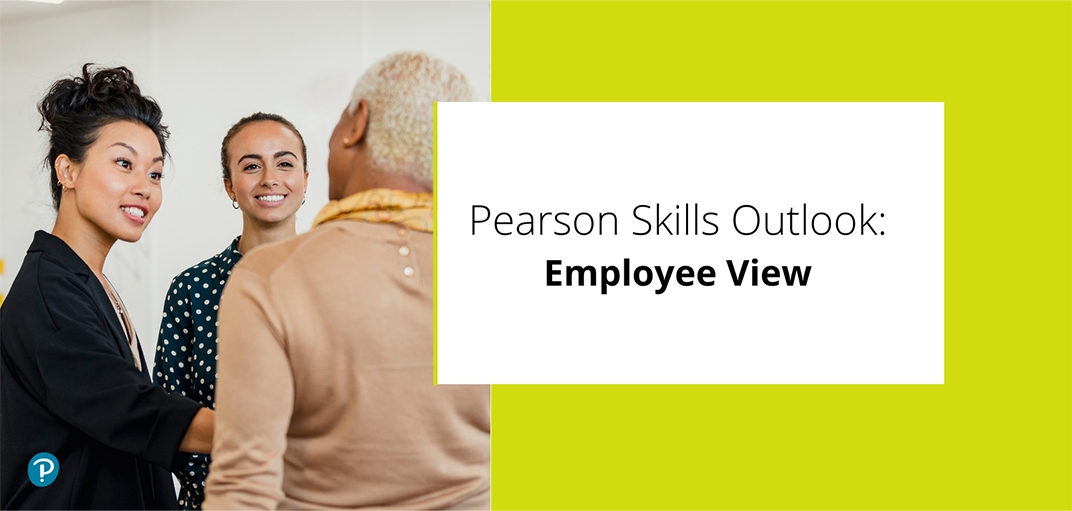Employers need them, employees want them, Pearson Research Scientist, Jessica Yarbro, shares 5 ways to boost human skills development on-the-job
We just released the second installment of our Pearson Skills Outlook series – a collection of short reports designed to provide a window into today’s world of work and learning.
The report, Pearson Skills Outlook: Employee View, set out to understand what skills workers are prioritizing in order to get ahead in their careers – today and in the near future. So, in partnership with Google, we polled 4,000 workers in four labor markets to see what skills they were most focused on developing.
The results show employees are preparing for a tech-focused world by sharpening their human skills. Things like problem solving, leadership, and teamwork. This complements the results of our first Skills Outlook report, which showed employers prize human skills most highly in their workforce.
There’s no getting away from it: human skills are in hot demand, and here to stay.
But how do you begin to sharpen your human skills? Insights sought advice from Principal Research Scientist, Jessica Yarbro. Part of Pearson’s HR team, Jessica specializes in Knowledge and Skills acquisition. Here are five top ways Jessica suggests you can lean into learning at work.
- Take an active role in your learning
The first Skills Outlook report revealed Personal Learning and Mastery as one of the top skills employers will look for by 2026. This means it’s time to get serious about professional development and to take a more active role in mastering new skills.
One way to do this is to approach workplace learning with a growth mindset. No matter how good we are at our jobs, or how senior we are, it’s about remaining open to learning new things and thinking about how we can move forward in the future. This mindset is key to overcoming challenges and setbacks along the way. “If you catch yourself thinking ‘I can’t do this’, try to add the word YET at the end of the sentence. Cultivating a growth mindset can really help you forge forward when you hit inevitable bumps in the road” explains Jessica.
Building a strong muscle for personal development and a growth mindset means you’ll be in the best shape to learn other, more technical skills, which is why employers see it as a prized attribute.
- Apply new skills in real life settings
Learning at work gives you a chance to practise in real-life scenarios. Say for example you want to get better at Problem Solving, which is one of the most sought after, and studied, human skills at work. You might take some in-house courses or do some research online. But how do you apply them?
“Be deliberate about finding opportunities to practice. Because we use human skills like problem solving every day, it’s easy to assume we are working on them all the time. But identifying the new strategies you have learnt, and intentionally applying them in real situations can solidify your learning. Analyze how the new approach works and practise again and again to refine the skill; suggests Jessica.
- Learn with others
Humans are social animals, and human skills are best learned with - and from - other humans. Jessica says “We learn automatically from observing others. Who are your colleagues that exemplify strong Teamwork or Leadership skills? Note the behaviors and strategies they use and try them out and see what works for you. Experiment with different strategies in different meetings to find the best results.
It also helps to learn as a pack. Feeling connected to others is a powerful motivator and can help us learn more effectively. Look for opportunities for social learning at work, establish a community of best practice, or tackle a challenging issue as a group. Finding ways to learn with others won’t only hone your Teamwork skills, but you’ll get the added benefit of improving other key human skills, like Communication and Collaboration”
- Seek feedback
Feedback is a powerful learning tool that can be tricky to find at work, so it’s one you might need to be proactive in seeking out. “Find a trusted colleague, or a manager, who is invested in your growth and development. It works best with skills you demonstrate to or in front of others – like writing, giving presentations, or leading a meeting. You could consider partnering with someone to share constructive feedback. Often, sharing your work or relaying something you’ve learned to another person can consolidate what you know, expose gaps, and help you see things from a different perspective.
- Stay motivated
We learn best when we see the value in learning. Jessica understands the power of seeing progress: “Believing we are competent and capable of achieving our goals makes us more likely to succeed. That’s why it’s important to set achievable, short-term goals and celebrate the small wins. Eventually, they will add up to a big win! Charting our progress and having a sense of accomplishment is a powerful motivator. That’s why using a portable skills profile, like Credly’s digital credential platform, is a great way to build a portfolio of verified skills to help keep you motivated and showcase your progress to your bosses and potential employers.”
A strong foundation of human skills is essential to employees and employers and the workplace is quickly becoming the heart of many people’s learning journey.
Workplace learning is something we’re investing in and thinking about a lot here at Pearson. Check out our Skills Outlook findings to find out more about how employers and employees are thinking about upskilling, now and in the future. Pearson Skills Outlook: Employee View


